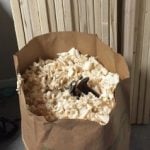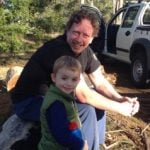#4 plane just not working.
Welcome! / Forums / General Woodworking Discussions / Tools and Tool Maintenance/Restoration / #4 plane just not working.
- This topic has 34 replies, 12 voices, and was last updated 7 years, 1 month ago by
rodrat.
-
AuthorPosts
-
I have a Stanley #4 plane and I am having problems getting it to plane. when I try to finish smooth a board I start to get little shavings (never full length) but it eventually stops and the plane just slides across the top, not cutting. I already checked to make sure the blade is razor sharp and it is aligned. As far as I can tell my plane bed is flat. Is there something I am doing wrong?
To get it to register the blade against the wood and take a cut I have to push the blade so far out that it takes too large a cut and just doesn’t function at all other than ruining the board.


Make sure you’re not “rolling the burr” onto the back of the blade. This can happen if your angle is too steep when stropping the blade. The blade will feel sharp, but the plane will only cut at the beginning of the board. Basically the burr (sharp edge) is on the back of the blade and therefore making no contact with the wood.
I’m probably not making any sense to you. Luckily Paul explained this in one of his Q&A videos on Youtube. Don’t remember which one, sorry.
Good luck.
Wesley
@tenjin I believe the angle is correct. Have no real way of knowing except cross examining with my other planes which all cut beautifully by the way.
@weslee that could be the problem but if I do ever get a cut It’s usually midway down the board. Hardly ever get a cut to start with it at the beginning of the board.In the mean time since its my only smoothing plane I have been making do with an old transotional wood bodied fore plane as a smoother, which surprisingly makes for a mirror finish. I can almost do all my planing with just it.
I’ll check the blade tomorrow when I get back into the shop but I got to say I’m really stumped. All my other planes work great, some of which I even made myself.
As others said, it is normally one of the four things…
1# Blade sharpness. Is it sharp enough to shave or slice unsupported paper at an acute angle.
2# Honing angle. ~30 degrees normally. Too shallow and it may blunt quickly, too steep and you lose the clearance angle and the plane skates.
3# Sole flatness. When you say ‘as far as you can tell the plane bed is flat’, how did you check it? there are plenty of online material about flattening/checking plane soles. Flatness is a bit more important when taking smoother shavings as these are normally extremely thin,.
#4 Incorrect setup for smoothing. Due to the extremely thin nature of the shaving needed for smoothing, the setup can be quite fiddly until you are familiar with a particular plane. Start with a very open mouth (>=2mm) and the chipbreaker/cap iron set well back (~2mm) and only adjust these once you know that the plane will cut predictably. Iron out any problems with these things individually e.g. gaps between cap iron and blade causing the plane to clog when the cap iron is set close.
It could also possibly be some mechanical problem with the plane. Does the blade move at all once adjusted into position? Is the cap iron or lever cap too loose? Does the blade sit flatly on the frog?
-
This reply was modified 7 years, 1 month ago by
Mike I. Reason: typo
@dragon32 I checked for flatness when I originally purchased it several months back using a straight edge i know to be square. I also followed it up with some sanding of the bottom on some glass plate and sand paper.
To better clarify what I meant when I said it would take a few shaving at the start, I mean it takes some of the high spots in the board. It leaves a surface that at first glance is flat but if you touch feels very bumpy. It’s almost like the blade isn’t making contact at all.
The blade is definitely still sharp even after I can’t get a cut anymore. It will shave your arm and I can eve get it to shave the top layer of a piece of paper off.
The bevel is somewhere in the ballpark of 30 degrees as is my other planes. I don’t use a honing guide (I have always sharpened my blades free hand since I was a child and my father taught me)
The blade sits as flat as I can get on the frog. That’s been one of my initial thoughts as to what might be wrong. It’s at least as flat as I can get it.
One thing of possible note: Now that I think about it the cap iron has since before I even owned it has been at just a slightly off angle. It’s tilted a bit meaning that there is a (almost unnoticeable) difference in length at the bottom. It’s something like a 1/64 inch or less difference at the edge of the blade.
I wouldn’t think that would be the issue as it sits tight against the blade and the difference per side is so miniscule. You dont think that could cause something like this?7 March 2017 at 9:13 pm #309872I found quite an interesting video about plane irons: https://youtu.be/5v9X9Cgtl7c It might help you or not. The main problem is, that you have to take a very close look at your blade, perhaps with a magnifying glass or even a microscope.
But it could indeed be the sole of your plane as well. You wrote “as far as I can tell”, which is a good hint, that you didn’t look hard enough. In fine woodworking, a thou is about surface finish. In metalworking, it is about shape (OK, that is a bit exaggerated, but close to the truth).
Dieter

It sounds like perhaps your cutting iron isn’t totally secure–it takes a few shavings and then stops shaving? Can you discern if it is still exposed to the same extent that it was when it took off high spots? How much of a gap is there between the base of the frog and the throat opening? What kind of wood are you planing?
Update: Just spent two hours working the plane over.
Fully sharpened the blade, grinded and set smooth the chip breaker against the blade. Leveled the frogs face (it is flat enough to cause suction against the blade now).
Also checked the sole. No light coming through between it and the straight edge, but I flattened it anyway.Meticulously cleaned, oiled and set it all back together.
Test cuts went as followed. After adjusting the blade to center I was able to get full length shavings across pine thin enough to read a newspaper through.
So far so good. Grabbed a scrap piece of oak. With the blade still set from the pine for an incredibly close shave i could hardly get a bite into the oak. Had to extend the blade further only to have it make a rougher cut.
Tried it on my current project, a cutting board im making out of hard maple. Wouldn’t start cutting at all. Just slid like a water ski across the top.
Checked the blade, it hadnt moved.
Went back to the pine and again took beautiful clear shavings off.
I’m at a loss here.

well, the oak and maple are certainly harder woods but that shouldn’t prevent the iron from grabbing.
2 other questions:
1) are you sure you were cutting with the grain vs. against it?
2) What are the dimensions of the wood you are trying to plane? If they are bigger surfaces, they may have more high spots that could prevent the iron from fully engaging until those high spots have been worked down (while maybe your pine was just a thin piece that you were edge-planing?) Of course I can’t be certain but I’m going by guess as I have often had difficulty surface planing larger pieces though I have been getting better at it as I’ve given more thought as to why the plane might be acting the way it does on certain surfaces). I started a thread about it a while back: https://woodworkingmasterclasses.com/discussions/topic/hardwood-surfaceface-planing-question/Sometimes it’s just a matter of taking little bits off the high spots until you eliminate them and the plane is engaged with more of the actual surface. It may not seem like you’re getting anywhere with the high spots but if the plane is properly set it will eventually remove enough of them that you’ll start getting fuller shavings. But yeah, I’ve certainly run into more challenges with hard woods and larger surfaces.
Any photos you can share (of the plane, the set-up or the wood/shavings themselves?)
-
This reply was modified 7 years, 1 month ago by
 David B.
David B.
 8 March 2017 at 2:57 am #309888
8 March 2017 at 2:57 am #309888It’s a mystery; doesn’t sound like you have done anything wrong in all that. I agree with dbockel2 that larger, flat surfaces with hardwood can be a problem for a smoothing plane. I’ve had that ‘skipping’ across the surface you describe when trying to flatten Eucalypt boards (very hard) but I haven’t over-thought it much and switched to a number 5 or 6 – for some reason they seem to work OK when the smaller one skips.
Maybe a few photos of the plane and the surface could give us some clues.
I am in fact going with the grain. I’ve been very good about making sure of that.
The maple board im trying to work on currently is 2″ thick by 6″ wide. It’s having trouble cutting the end of the board as well as the face.
I can get some pictures tomorrow. Or at least try too.
Yes, it does sound like a bit of a mystery and you haven’t done anything silly. There must be a simple and logical reason behind it, but it’s a question of finding it, of course and we all hope you do!
I wondered if the blade was moving back in due to some play somewhere, but you say that it still appears to have the same setting when it won’t cut the hardwood.
I am only thinking aloud here, but perhaps there is some play somewhere that is more evident with the hardwood due to the increased resistance. Perhaps the blade assembly can spring & move in/out during the cut by even the minute amount of the thickness of the shaving.
How tight is the lever cap and does it seat evenly on the cap-iron/chipbreaker? I have sometimes had problems with the blade readjusting in the cut if the lever cap isn’t tight enough, but usually these have been “one way” adjustments and pretty large/obvious.
Also, you flattened the face of the frog and the blade seats well, but how well does the frog seat on the plane body? Are you sure that the screws holding the frog to the body are not loose? Sometimes people leave these partially tightened to aid mouth adjustment or simply forget to tighten them after adjusting the mouth (done that one myself!).
If you have a spare blade/cap iron that you have successfully used in another plane body, you could try testing with that in the problem smoother body. That way you may be able to at least narrow the problem down to definitely the blade/cap iron or the plane body.
Clutching at straws here too, but I also remember Paul blogging about depth adjustment yoke issues.
https://paulsellers.com/2015/02/thick-irons-beware-the-unequal-yoke/
It may be worth checking that the depth adjustment yoke engages properly with the rectangular cutout in the cap-iron. In Paul’s blog he is mainly talking about the yoke not engaging enough, but I have also read somewhere that the opposite can also happen where the yoke is slightly too long, and passes too far through the rectangular cut out in the cap-iron and sits very slightly proud of the cap-iron. This could possibly in some scenarios interfere with the action of the lever caps cam lever and prevent the lever cap from tightening up properly.
-
This reply was modified 7 years, 1 month ago by
-
AuthorPosts
- You must be logged in to reply to this topic.
